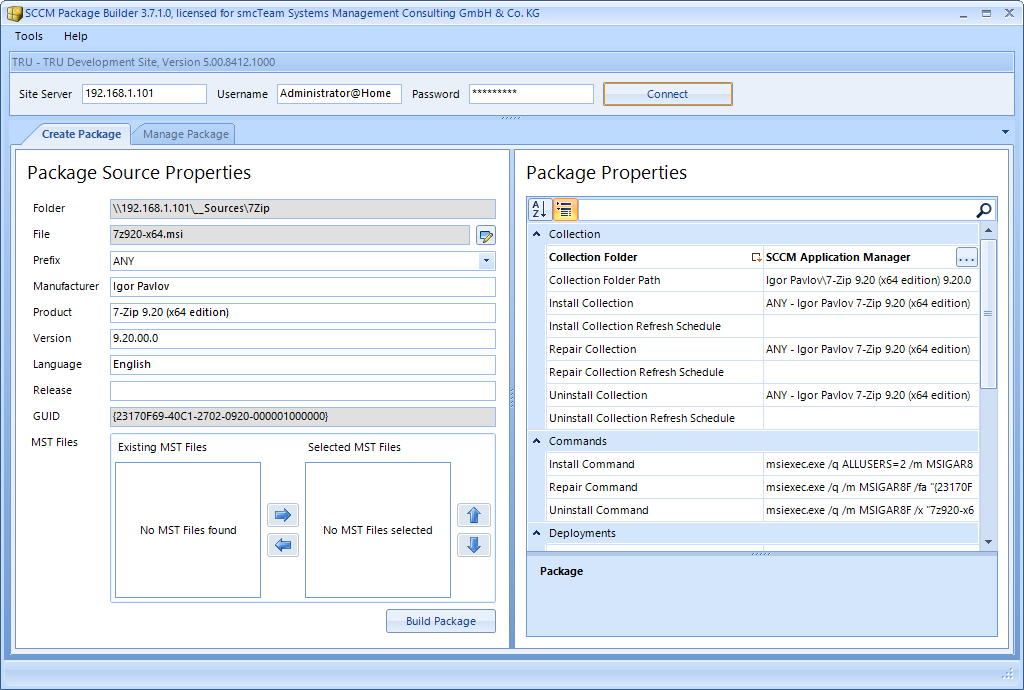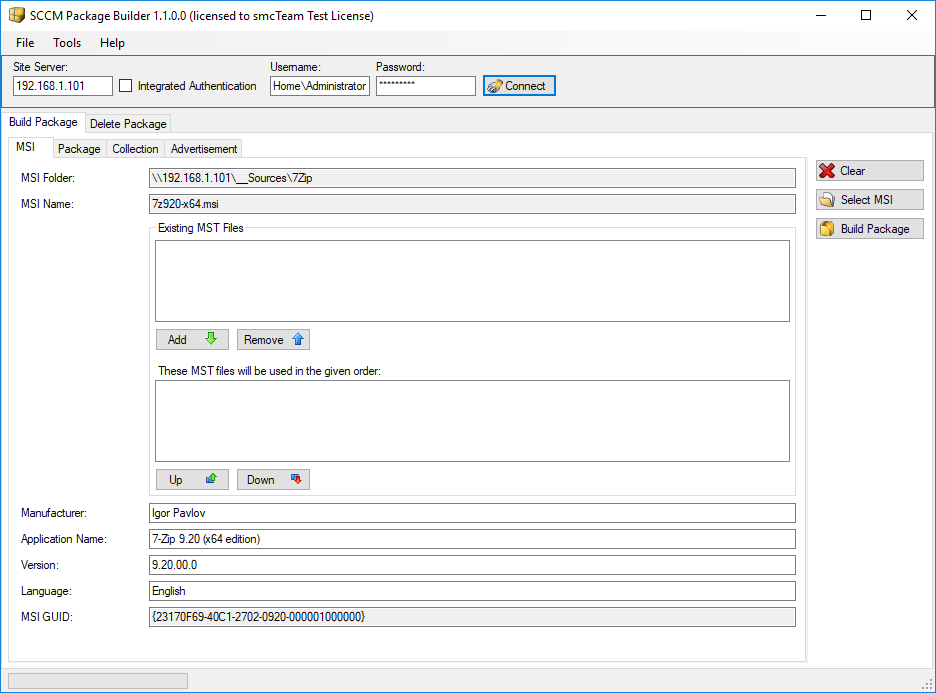Changelog
Explanation:
Green annotation: New Feature
Yellow annotation: Note
Red annotation: Bug fixed
Version 3.0.3.0 (2024-03-11)
Error fixed: Property Release reactivated.
Version 3.0.2.0 (2023-05-25)
Error fixed: Detection Rule Template X OR Y becomes X AND Y after check-in.
Version 3.0.1.0 (2023-03-24)
New global setting Ignore Security Scope Permission Check to disable whether the logged-in user has permission on all object instances or not.
For applications the Localized Description and for packages the Package Description can be specified in multiple lines.
(However, the specification of multiline descriptions for packages is not yet supported by MECM).
Version 3.0.0.0 (2022-04-06)
Support for devices and users when creating applications, packages or when editing group memberships.
Support of the repair function for applications.
With automation, an icon file can optionally be specified when creating applications.
When using global configuration settings, the configuration file Global.cfg must be recreated if it was created with a previous version, as it is incompatible with the current version.
This version requires .NET Framework 4.8.
Version 2.7.4.0 (2020-03-16)
Automation allows you to optionally specify the GUID for a specific connection to a SCCM site.
Version 2.7.3.0 (2020-03-11)
With the new automation feature, the creation and deletion of applications and packages as well as various status changes can be done using scripts.
Version 2.7.2.0 (2020-02-14)
Berücksichtigung der mit der Version 1906 neu eingeführten Berechtigungsklasse für Ordner (Infos siehe hier).
Multiple connection settings, including the color palette, can be saved.
Dynamic status changes for applications and packages. In this case, the corresponding objects are promoted or demoted by one level depending on their current status.
For applications, wildcards can be used in the fields Description and Localized Description, as well as for packages in the Package Description field.
Improved display of applications and packages.
Version 2.7.1.0 (2019-11-18)
When creating applications with a large number of source files, the application could initially be created, but later on it could not be edited. Instead, the following error message appeared: The object reference was not set to an object instance.
Version 2.7.0.0 (2019-09-02)
One or more existing Administrative Categories can be added to an application.
For applications, the values for Maximum Allowed Runtime Minutes and Estimated Installation Time Minutes can be specified.
When creating applications, images with a maximum size of 256 x 256 pixels can be specified.
Repair collections were not removed when deleting packages.
Version 2.6.3.0 (2019-04-29)
After a change of status from applications or packages, it may be necessary to define other DP groups. To ensure that this is not forgotten, a corresponding reminder message appears, which can be defined in advance.
In the case of an "update content" of applications, file changes were not updated on the DP.
When switching from one site to another within the SCCM Application Manager, the data for applications and packets were not reset which caused an error.
Version 2.6.2.0 (2018-11-12)
This version requires at least .NET Framework 4.7.1.0.
When a status was changed within applications or packages, the new status was displayed on the screen, even if none were defined.
When defining certain deployment rules, the following exception was thrown: "Invalid expression: either datatype of operands do not match or the operator is invalid for the datatype".
Version 2.6.1.0 (2018-08-07)
When working with applications, the menu item Update Distribution Points was renamed to Update Content and the functions in the background have been adjusted to match the functions within the Configuration Manager Console.
When using more than one detection rule, the Configuration Manager Console crashed with the exception "Expression must have a setting reference".
Version 2.6.0.1 (2018-04-16)
In the Date published value, the month and day were swapped. Therefore, an application that had been created on 01/12/2018 was only available on 12/01/2018.
The start time for deployments was shifted one or two hours later which also caused deployments to run later.
Version 2.6.0.0 (2018-03-26)
New field Uninstall Registry Key within the Source Properties, so that valid detection rules can also be created for applications that do not have a product code in the form of a GUID.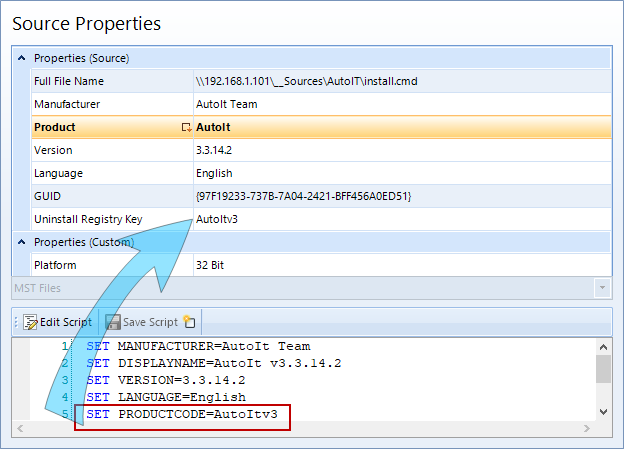
When using the Detection Rule Editor and the Setting Type is Windows Installer the place holder {Version} can be used in the Value field.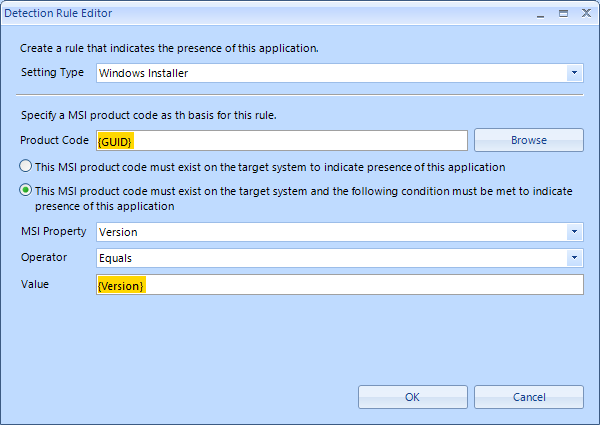
When using the Detection Rule Editor and the Setting Type is Registry the fields Path and Value can be filled in with place holders.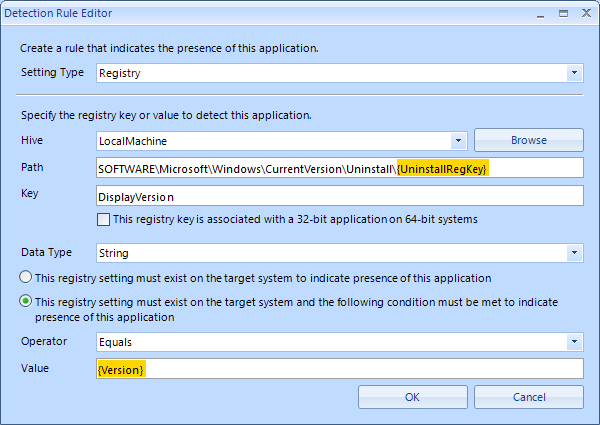
Membership rules can be imported from a file or exported to a file using Import Rules and Export Rules.
If the operator Equals was specified in the Detection Rule Editor within the settings Windows Installer, the operator Not equal to has been incorrectly identified.
If a vbs or a cmd file was loaded after a ps1 file was loaded, the script editor showed PowerShell errors.
Fixes of some typos in messages.
Version 2.5.4.2 (2018-01-22)
False positive message in spite of a valid license.
Version 2.5.4.1 (2017-12-12)
An exception was thrown when trying to configure the SCCM Application Manager without a connection to the SCCM Server.
Version 2.5.4.0 (2017-12-06)
Code review of the status change to fulfill different requirements.
The application/Package check considers different deployment options.
Version 2.5.3.4 (2017-12-04)
An exception was thrown when deployment flags, program flags or remote client flags were set to null.
Version 2.5.3.3 (2017-11-26, Sunday Compilation)
Application state cannot be changed if description is empty.
Version 2.5.3.2 (2017-11-24)
No icon assignment possible when working with scripts.
The application icon does not disappear when a new application source was selected.
The custom properties editor does not detect all changes.
Version 2.5.3.1 (2017-11-23)
Working with global configuration files needed change permissions instead of read permissions.
Version 2.5.3.0 (2017-11-17)
Version Control
Maintenance Mode
The property 'Info Url' opens a file browser instead of an Url editor.
Version 2.5.2.0 (2017-11-13)
Support of limiting collections
Version 2.5.1.1 (2017-11-08)
"Misunderstanding" when 'Igor Pavlov' and 'AVL' were in the same manufacturer list.
Version 2.5.1.0 (2017-11-07)
New column 'State' when working with applications/packages.
The field 'Description' supports the place holder {State} which will be replaced at runtime.
Version 2.5.0.0 (2017-10-26)
A bunch of different deployment options for applications and packages
Version 2.0.2.0 (2017-10-13)
VB Script support included ...after 10 years PowerShell.
Version 2.0.1.1 (2017-11-08)
Forgotten which one.
Version 2.0.1.0 (2017-07-24)
Global configuration files can be changed if the user has write permissions.
Icons can be assigned to applications.
Version 2.0.0.0 (Juni 2017)
Integration of the PowerShell App Deployment Toolkit
Die SCCM Application Manager Historie
A brief overview about older versions.
Version 1 of the SCCM Application Manager supported Microsoft® System Center Configuration Manager 2012. The development started in 2016 and it was the first version that could work with packages and applications.
The father of the SCCM Application Manager was called SCCM Package Builder. It was supported until 2015 and worked with versions from the Microsoft® Systems Management Server 2003 up to the Microsoft® System Center Configuration Manager 2007. It only created packages. With the beginning of the SCCM Application Manager development in the year 2016, the development of the SCCM Package Builder was discontinued.
One of the last "photos" of the SCCM Package Builders grandfather we developed in 2006. It was designed to work with Microsoft® Systems Management Server 2.0 and Microsoft® Systems Management Server 2003.

